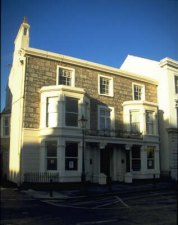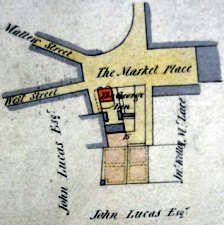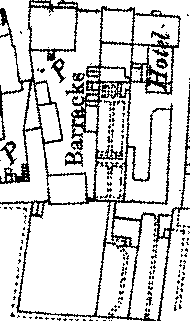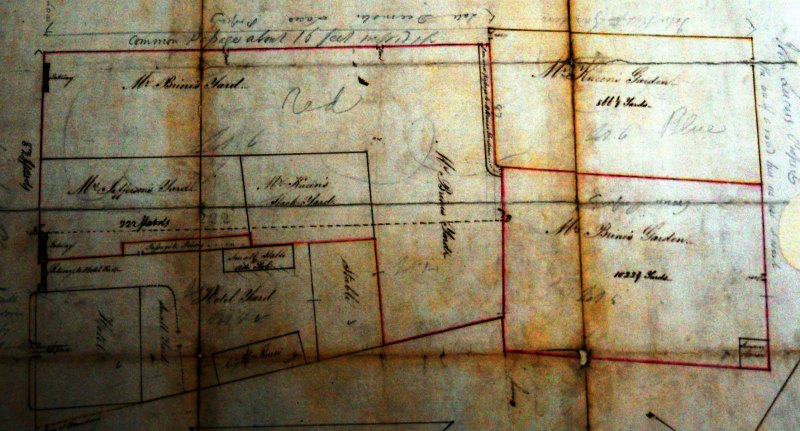
The George Hotel c.1990

The George Hotel c.1990
The George Hotel in Castletown occupies a key position at the west end of the Parade facing the Castle - its history is interesting and somewhat confused. T.M. Moore in his account of Castletown in the 18th & 19th Century adds somewhat to the confusion :
...The greatest meeting place in the town was the George Inn, which has a large assembly room at the rear.
The first reference to "The George" is in the Manx Mercury of 1793; it mentions an Assembly at Downes's rooms. Mr. Downes was host at "The George". He was an elderly Englishman and a true 'John Bull', who had been in the Manchester Regiment. In 1820 he died, and his widow carried on the business. His son, William Downes, was a well known merchant who lived in The Crofts at "Croft End".
In Circa 1830 "the George" was rebuilt by the Duke of Atholl, who owned it. There is an elegant design of it attributed to Thomas Brine, who was the architect for St. Mary's Church. Brine's design had a portico with a balcony on top. The window above the balcony had a surround in the Italian style. However, the design was never entirely carried out as "The George" had only three windows across the facade at the top; whereas Brine's drawing had five. In the 1880s the lower facade was completely altered by the introduction of bay windows.
Nevertheless, "The George" is an interesting building, and it is worth noting its depth back from the Square. On the first floor there is a large assembly room with a Georgian alcove at one end, where much merry-making took place in the early nineteenth century. Behind the hotel the original stables remain intact.
The Manx Advertiser records amusements held at "The George"-
1805, Oct. 14th: By permission of His Excellency the Lieutenant Governor
At Downes's long room Castletown (For one night only).
Mr. Bell from the Theatre Royal, Edinburgh will perform the celebrated "Collins's Evening Brush".
To sweep away the canker of care, and dislodge the cobwebs of Melancholy.
Divided into four parts.
After the Brush, Mr. Bell will deliver Tony Lumpkin's Rambles with Pet Boucer
Through London, Woolwich and the Isle of Man.November 2nd, 1811 The Manks Advertiser reports-
"Mr. Banks' Ball at Mr. Downs' Assembly, Castletown on Friday Evening (the 25th) was attended by a greater number of ladies and gentlemen than was ever before witnessed there on a similar occasion. The young ladies and gentlemen acquired themselves, through a variety of new and elegant dances in a manner which reflected great credit on themselves, as well as their teacher, and received the highest applause of a most numerous and brilliant assemblage of the ladies and gentlemen of Castletown and its neighbourhood."
The confusion is indicated by the two plans shown below
 From MPE 1/1053-3 c.1834 |
 From 1868 O/S plan of Castletown |
The earlier plan indicates the position of the George as the west most part of the plot whereas the 1868 plan indicates it as at the other end of the plot - this plot had for many years prior to the 1765 revestment been the site of the Governor's house opposite the old Market Cross and across the parade from the Castle. Under the 1765 Act of Revestment it had been claimed by the Duke of Atholl as his Manorial property - this passed to the Crown by the 1826 purchase of all the Duke's Manorial rights on the Island and was managed by the Department of Woods and Forests in London.
The gardens on the south side of the plot were however originally part of the Knock Rushen flatt - there is a deed SSS Oct 1750 #63 -
[Castletown]dated 28 Apr 1749;Rhoda Makon(widow) + Abigail + Mary Makon(spinster) give to Wm Makon any right we might have to a certain house William is now erecting or rebuilding with a proportionable part of our garden + outhouses being part of our houses backward of the Governor's house and thereto adj rent 3s 4d;Wm not to sell or mortgage during our lives;Witt Wm Curghey, John Queeing.
It would appear that the Duke of Athol bought this property off the Makon family.
The file of plans held at the UK National archive includes an 1831 plan MPE 1-1053-2 titled "Ground Plan of the George Inn Castletown together with the Stables, Coach Houses, Yards, Garden &c &c now occupied by Mr Kneen under rent from the Crown. Also the Yards Garden and other appurtances occupied by Mr Brine under rent from the Crown and partly sublet to Mr Jefferson and Mr Kneen" Wm Steel Octr 1831.

Photo enhanced from MPE 1/1053-2
The plan would appear to have been drawn for the possible sale of the properties - that of Mr Brine's yard is mentioned in Castletown Deeds Michael term 1832 No. 1 -
[Castletown]dated 4 Sep 1832;Thomas Brine(Castletown) + wife Ann sell for £135(British) to Thomas Jefferson(farmer,Ballahot, Malew) all the remaining part of a parcel of ground in Castletown purchased from the Commissioners of Woods etc by deed dated 17 Apr 1832 marked red on plan, part of which I have sold to Edward Gawne, Robert Quayle + John Quayle for purpose of erecting a new Inn by deed dated 20 Aug 1832 [SSS May 1833 70a] wch sd lands hereby sold are 37ft in front adj Parade or Market place and extend backwards in a parallel line with that sold to messrs Gawne etc to a passage wch leads to a garden belonging to the Crown now in occp of sd Thomas Brine,premises adj Crown property on NW, sd Market place on NE, rent sd Edwd Gawne et al on SE and sd passage on SW together with undivided NW half of that garden marked blue on plan wch adjoinss Crown property on NW, sd passage on NE, Edwd Gawne et al on SE and John Lucas on SW; Witt R Kelly, J A Brew
The plan above has pencilled annotation 'Red' for the section of the plot other than that containing the George Inn - Brine is selling the middle section having previously sold the upper section to the consortium headed by Edward Gawne. He had bought the garden to the rear of the site of the new George earlier in 1832 (CTD Mic 1832 3)
[Castletown]dated 23 May 1832; Commisioners HM Woods, Forests, Land Revenues, Works + Buildings( Wm Posonby(Vicount Duncannon) + Wm Davies Adams) sell for £300(British) to Thomas Brine(Castletown) all that parcel of garden coloured blue on plan containing 866 + six ninths yards bounded on NE by a passage sep garden from the yards
The George Inn shown above was the not original Governor's house but Mrs Bullock writing of Castletown in the 1810s notes re the buildings of Castletown " All those now in existence appear to have been raised within the last century, except one, now the George Inn, but formerly the abode of the lieutenant, and of the lord himself when on the island". She also notes the very necessary improvements at Castle Rushen needed to make the gaol fit for use that started to be put in place around mid decade.
My own thesis is that Governor John Wood was possibly the last to occupy the Governor's house, though there is some doubt, but certainly the following Governor, Edward Smith, generally lived in London under an arangement with Lt.-Governor Richard Dawson, who lived in some appartments within the walls of Castle Rushen, whereby one of them had to be always on Island. Thus certainly post the death of Wood in 1777 the old house would have been free for the Duke or his agents to rent out as an Inn. The use of Castle Rushen to contain the Governor's house is confirmed by the Duke of Atholl who was long in dispute with London appointed Lt-Gov Smelt to have use of the house, stated that Gov Smith and Lt-Gov Dawson had allowed him to use the house within Castle Rushen.
Mathieson also adds to the confusion re the property as in his section on the Inns of Old Castletown he writes in one section:
When the GEORGE first opened its doors I have been unable to discover, but there are several references to it in the Manks Mercury during 1793. From the ‘Swarbrick’ MSS. (in the Manx Museum) we learn that in 1815 the host was one Downes, ‘an elderly Englishman and a true John Bull’ , who had been a sergeant in the Manchester Regiment, but ‘having retired from the din of arms appeared to enjoy Otium cum Dignitate.’ In 1820 he died, but the business was carried on by his widow, for whom the Duke of Atholl, who owned the house, rebuilt it in 1823. There is a local tradition that the original building was the one which afterwards served as a barracks, and later still as the offices of the Town Commissioners. I can find no grounds for this belief, however, and think it much more likely that the new hotel —the one we now see — stands on the same ground as did its predecessor.
In another later addition he notes:
The GEORGE. When Downes died, at the age of 76, in October 1820 he was said to have been landlord of the George ‘for upwards of forty years’ so it must have been in existence from at least c. 1780. After his death the old building was pulled down, and replaced by a new one which opened in July 1821. During the demolition long-hidden evidence of some old crime or tragedy came to light when the skeleton of an infant was found behind the wainscoting of one of the rooms. When the new building was opened Mrs. Downes — who had take her husband’s place when he died — handed the business over to Mr. T. Kneen, and under him and his successors the George continues to this day to serve as the centre of social life in the old Capital. For a short period during 1853 to 1855, while W. Ockerby was the landlord, the George seems to have been called the LANCASHIRE AND YORKSHIRE. Its appearance was altered about the year 1880, when the present more modern type of windows were built.
Downes would appear to have arrived at the George sometime in 1791 as in October of that year his name was first entered in the list of those holding recogninances for holding a Public House Licence.
The rebuilding, or possibly a renovation, was done within some six months as a meeting of the Castletown Bible Society was held at the George Inn on the 23rd of January 1821 and the opening of the new George is recorded as early July.
Rising Sun, Saturday, 30th June 1821
The New George Inn. at Castletown, is finished, and will be opened next week. It is particularly commodious, and the rooms both for sitting and sleeping, are delightfully spacious. The Ball Room is about 45 feet by 23, and. will be opened on the 19th July. We regret that the worthy gentleman for whom it was originally intended, had not lived to see it finished; but we doubt not it will be conducted as the Old George than which nothing can be better.
Mathieson was incorrect re the position as the New Barracks at Castletown did indeed occupy the site and, probably the same building, as that rebuilt by the Duke as shown by the plans above and the following newspaper reports
Manks Advertiser, Tuesday, 17th January, 1832; Page: 3
NEW BARRACKS.
It is rumoured that a public accommodation is about being made in Castletown, for the reception of the military stationed there. The fine large and roomy building, erected by his Grace the late Duke of Atholl, and rented as the George Inn, is to be converted into a barracks. This appears prima facie to be an exceptionable arrangement, so far as the beauty of the town is concerned, and may possibly affect the adjoining and neighbouring properties. But when it is further considered that much will depend on the architectural arrangements, in having the soldiers' apartments and liberties to the back parts of the building, reserving the front for the accommodation of the officers, &c, with armorial ornaments of classic elegance in front, it would convert that house into a handsome public building, which, instead of being a nuisance, would be an object of considerable beauty. The domicilia might likewise, and doubtless would, be rendered perfectly inoffensive to the vicinage, by the enforcement of that military discipline of order and consummate cleanliness which distinguishes the camp.
Manx Sun, Tuesday, 1st January 1833; Page: 3
(From a Correspondent.)
It having been determined that the buildings of the George Hotel, Castletown, should be converted into barracks for the use of the troops in the garrison, a new Hotel will he erected in that town, and the 26th of December, St. Stephen's Day, was the day appointed for laying the foundation stone thereof. This ceremony was performed by Edward Gawne, Esq., of Kentraugh, who was furnished with a silver trowel on the occasion, accompanied by the principal gentlemen of the town, and surrounded by a concourse of spectators. The trowel was presented to Mr. Gawne by Mr. Welsh, the architect, who has contracted for the building. In the centre of the foundation stone was deposited a copper box, containing a parchment scroll bearing an inscription, as well as some ancient and modern coins. The laying of the stone was accompanied by three cheers from the spectators, and the band of the Artificer's Society played " God Save the King," and other national airs. The company then had refreshments on the ground, and success to the undertaking was toasted with enthusiasm. An elegant dinner provided by Mr. Kneen was well attended, as was a supper by the artisans who are building the college, and who are engaged to erect the new inn. At the festive boards, mirth and good humour prevailed, and many loyal and constitutional toasts were drank in right Manx fashion. The following is a copy of the inscription deposited in the foundation stone:
THE FOUNDATION STONE
of this building, erected by public subscription of the gentlemen of this town and its vicinity, for the public accommodation, was laid by Edward Gawne, Esq., assisted by John Kelly, Esq., High Bailiff, John M'Hutchin, Esq., Cleric of the Rolls, George Quirk, Esq., and others, subscribers and well-wishers of the undertaking, on the twenty-sixth day of December, one thousand eight hundred and thirty two, being St. Stephen's Day, in the third year of the reign of his most gracious Majesty, William, by the Grace of God King of Great Britain and Ireland, and of Adelaide, his Queen ; and in the first year of the governorship of his Excellency Colonel John Ready.- The designs furnished and carried into execution by John Welsh, architect.
Gloria Deo.
LIST OF SUBSCRIBERS.
John M'Hutchin, Esq., C. R; Edward Gawne, Esq.; George Quirk, Esq., W. B.; Robert Quayle, Esq.; John F, Crellin, Esq.; John Quayle, Esq.: John Kelly. Esq., H. B.; Thomas Moore, Esq.; Thomas Fellowes, Esq.; Mr. Thomas Kneen.
The new George was opened some 15 months later -
Mona's Herald, Friday,14th March 1834
GEORGE INN, CASTLETOWN.
T KNEEN, in returning best Thanks to his Friends and the Public, takes leave very respectfully to inform them that he has removed to the NEW HOTEL, recently built and fitted up on the Parade.
In point of Accommodation and Comfort, T. KNEEN confidently hopes all the Compartments of the Building will be found superior in their kind; and the Wines, Spirits &c., with which he has furnished his Cellars will also, he trusts, ensure to him the distinguished Patronage with which he has hitherto been honored, and which it will always be his highest gratification to deserve.
Superior Stabling, Coach Houses, &c. &c.
Castletown, March 13, 1834
Kneen had requested the Commissioners of Woods & Forests that his lease on the 'old' George be allowed to continue until the 'new' George was completed but in early May 1834 James McCrone, then Crown Agent, wrote saying his request was refused and on the 20th May he wrote to the acting Attorney General James Quirk to begin proceedings against Kneen and to barrack master S Nobel that steps were being taken to give him possession.
It would appear that the soldiers had moved into their new barracks, by November 1833 the buildings on the Quay, which had been used as Barracks were put up for rent
Mona's Herald, Friday, November 15, 1833;
Also, To be LET, for a Term of years, or otherwise, That capital WAREHOUSE, situate on Castletown Quay, lately occupied as Government Barracks. The House is spacious, and well calculated for Grain Stores, their being abundance of air. It is three Stories high, and would contain about 800 Bolls.
Possibly this was the building, on the Irish Quay on the other side of the Silverburn from the Castle, that became the Umber warehouse.
There is however still a minor mystery to be tidied up as throughout much of 1812 and 1813 the following advertisement appeared
Manks Advertiser, Saturday, 15th February 1812
NEW GEORGE INN,
Near the BANK, CASTLETOWN, P JOHNSON returns his grateful Acknowledgments to the Inhabitants of this Island, and Gentlemen Travellers, for the liberal Encouragement he has experienced during his Residence in the above Inn, and assures them, nothing shall be wanting to ensure a Continuance of their Favours.
* * * Dinner every Day at 2 o'Clock, as usual Good Stabling, and Saddle Horses to Hire, on the shortest Notice. Castletown, January 2, 1812.
As Mathieson notes it would be strange for two hotels of the same name to co-exist in the town, and if his identification of the Bank is indeed Bank Street within 100 yards of each other. The George Inn would still appear to be operating as the daily stage coach ran from it to/from Douglas.
|
|
||
|
|
||
|
Any comments, errors or omissions gratefully received
The Editor |
||